Next Lesson - Development of the Respiratory System
Contents
- The Nasal Cavity
- The Pharynx and Larynx
- The Upper Airways
- Chronic Obstructive Pulmonary Disease
- Cystic Fibrosis
- The Thoracic Cavity
- The Intercostal Muscles
- The Intercostal Arteries, Veins and Nerves
- The Diaphragm
- The Movements of the Thoracic Wall and Diaphragm During Respiration
- The Pleura and Pleural Cavity
- The Trachea and the Bronchial Tree
- The Lungs
- The Neurovascular Supply of the Lungs
- Visualising the Lobes of the Lungs and The Pleural Cavity
- Quiz
- Feedback
Abstract
- The nasal cavity is divided into the left and the right, providing an entrance for air. This air is warmed & moistened as it enters the nasal cavity, whilst expired air is cooled to recover the water.
- The pharynx is split into three regions: nasopharynx, oropharynx and laryngopharynx. The pharynx and larynx work together to ensure food enters the oesophagus and air enters the trachea.
- The upper airways are split into the respiratory and conduction portions. The conducting portion is defined as being from the nasal cavity to the terminal bronchioles and is responsible for the transport of air to the gaseous exchange surfaces. The respiratory portion is from the respiratory bronchioles to the alveoli and is the site of gaseous exchange.
- Patients suffering with chronic obstructive pulmonary disease have inflammation of the airways, meaning they have an increased risk of developing infections.
- Patients suffering from cystic fibrosis have thickened mucus in their airways due to less water being able to enter the mucus from the cells lining the respiratory tract. This leads to patients having an increased risk of developing respiratory infections.
- There are three muscles present in the intercostal space, and from superficial to deep they are: external, internal and innermost intercostal muscles.
- The neurovascular bundle of each rib runs on the inferior border of the respective rib (superiorly in the intercostal space), and this is important clinically as chest drains must be inserted inferiorly in the intercostal space.
- The diaphragm is the main muscle involved in inspiration and when it contracts, it flattens to increase thoracic space. This causes the lungs to inflate.
- The pleura is made up of two serous membranes – parietal membrane, which lines the inside of each hemi-thorax, and the visceral pleura lines the outside of the lungs and extends into the interlobar fissures.
- The trachea commences at the lower border of the cricoid cartilage and terminates by dividing into the right and left main bronchi at the level of the sternal angle.
- The right lung has three lobes and the left lung has two lobes.
- A tumour in the apex of either lung can lead to the patient presenting with neurovascular symptoms due to the close relationship of the apex of the lungs with blood vessels & nerves.
- The lungs have a dual blood supply, the pulmonary system and the bronchial system.
Core
The respiratory system allows the body to take in oxygen and expel carbon dioxide. This process oxygenates the blood and removes carbon dioxide produced by respiring cells within the body. This article will cover the anatomical structures that form the respiratory system as well as the neurovascular supply to it.
The nasal cavity is divided into the left and right nasal cavities by the medial nasal septum. Air enters the nasal cavity through the nostrils and passes into the nasal vestibule, which is lined by keratinised, stratified squamous epithelium. The nostrils of the nasal vestibule are lined with nasal hair, which filter dust and any other foreign materials. Within the nasal vestibule, the epithelium changes to ciliated pseudostratified columnar epithelium (respiratory epithelium).
On the medial surface of the nasal cavity, there are three outgrowths called conchae or turbinates. They increase the surface area for inspired air to be warmed and moistened on the way in, and for expired air to be cooled on the way out.
As well as warming and moistening inspired air, the nasal cavity is also used as a resonance chamber in the production of speech and in olfaction (smell).

Diagram - The structures in the nasal cavity
Creative commons source by Stella Gänger and Katharina Schindowski [CC BY-SA 4.0 (https://creativecommons.org/licenses/by-sa/4.0)]
There are four paranasal sinuses located around the nasal cavity and they are connected to the nasal cavity via small orifices called ostia. The ostia can become blocked if inflammation is present, such as in situations like allergic reactions and infections. These can lead to the drainage of mucus from the sinuses being disrupted, causing sinusitis to develop. The four paranasal sinuses and where they are found can be seen in the diagram below.
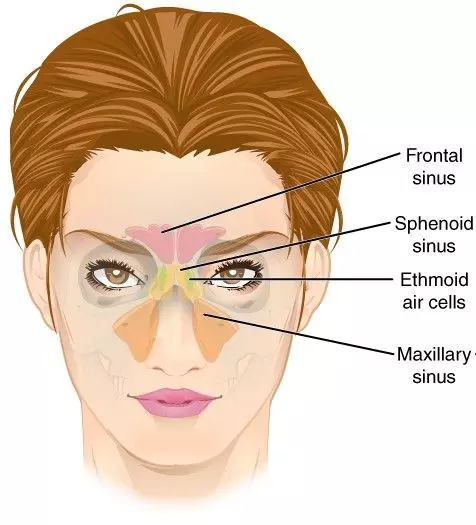
Diagram - The paranasal sinuses
Creative commons source by OpenStax College [CC BY-SA 4.0 (https://creativecommons.org/licenses/by-sa/4.0)]
In the pharynx, air and food have a common passage ,which connects the nasal cavity, oral cavity and trachea together. The pharynx is split into three sections: nasopharynx, oropharynx and laryngopharynx. Both the pharynx and larynx work together to ensure food enters the oesophagus and air enters the trachea.
The vocals cords are found within the larynx. During the process of swallowing, the laryngeal inlet becomes narrowed followed by the epiglottis folding downwards. Finally, the vocal cords adduct to act as a sphincter to close off the entrance to the trachea thus preventing food or any other foreign objects from entering.
If the larynx and vocal cords become dysfunctional, there is an increased risk of inhalation of food or liquid due to the inlet to the trachea not properly closing.
The coughing mechanism allows particles and objects to be expelled from the trachea. In this mechanism the vocal cords adduct, allowing intra-thoracic pressure to build up, which is then followed by quick abduction of the vocals cords that expels air and particles out of the trachea in a cough.
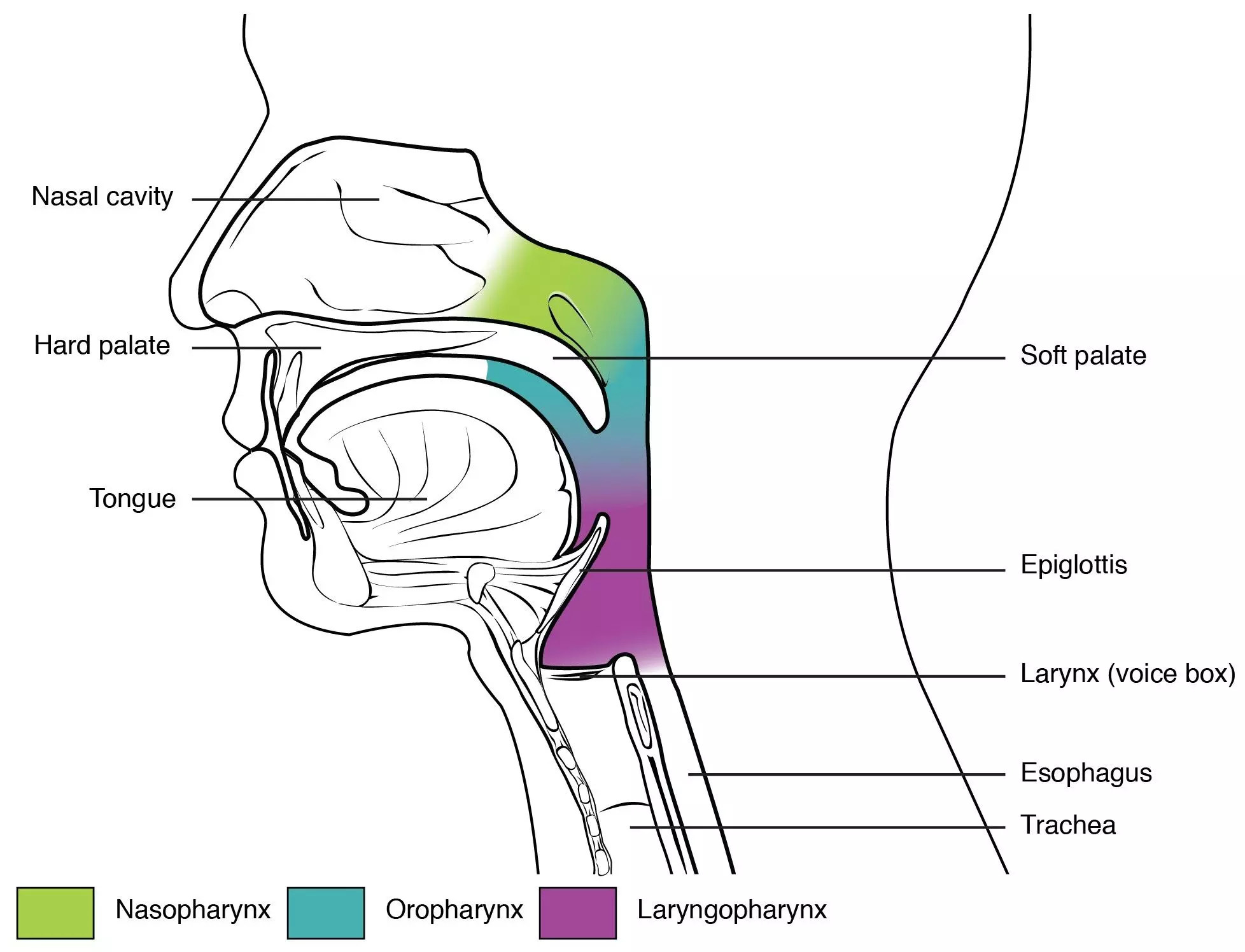
Diagram - The sections of the pharynx, with the nasopharynx in green, the oropharynx in blue and the laryngopharynx in purple
Creative commons source by OpenStax College [CC BY-SA 4.0 (https://creativecommons.org/licenses/by-sa/4.0)]
The airways are split into two regions: the conduction portion and the respiratory portion. The condition portion is described as being from the nasal cavity to the terminal bronchioles and is responsible for the transport of air to the gaseous exchange surfaces. The respiratory portion is from the respiratory bronchioles to the alveoli and is responsible for the site of gaseous exchange.
The trachea is lined with cartilage in a C shape and the presence of this cartilage ensures the trachea remains open under the negative pressure that occurs during breathing. The cartilage changes shape in the primary bronchi to a full ring, and changes again to a crescent-shaped structure in the secondary and tertiary bronchi.
Alveoli are found at the end of respiratory bronchioles, attached to alveolar sacs (collection of alveoli). Alveoli are the sites of gaseous exchange of carbon dioxide and oxygen.
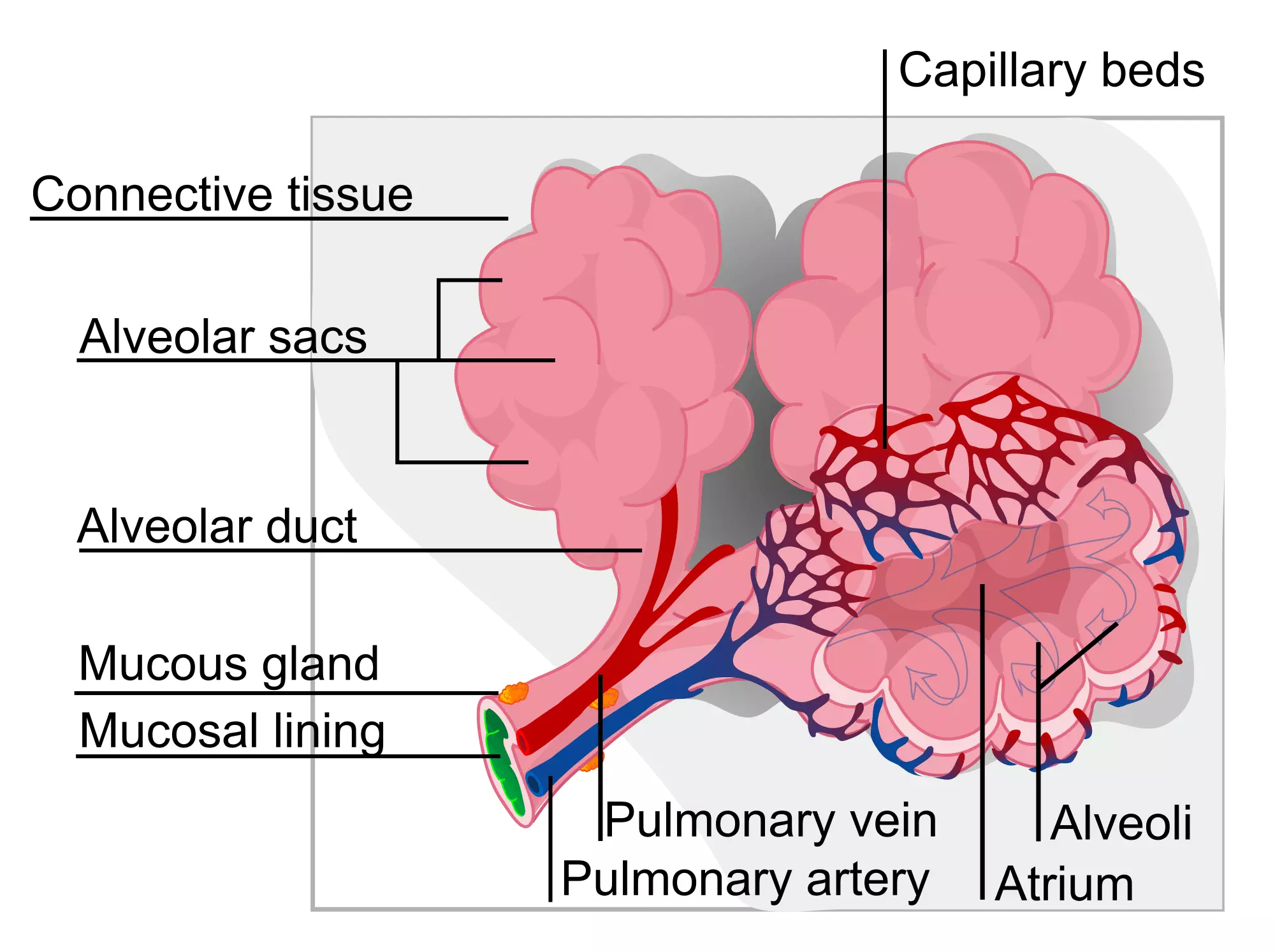
Diagram - The structure of alveolar sacs
Public Domain Source by LadyofHats [Public domain]
The epithelium found between the nasal cavity and the secondary bronchi is pseudostratified ciliated epithelium with goblet cells. The goblet cells produce and release mucus, which traps microorganisms and inhaled particles. The cilia then waft the mucus up to the pharynx to be swallowed and digested in the gastrointestinal tract. From the bronchioles onwards, the goblet cells are replaced by the Clara cells, which produce and secrete surfactant that prevents the walls from sticking together during expiration.
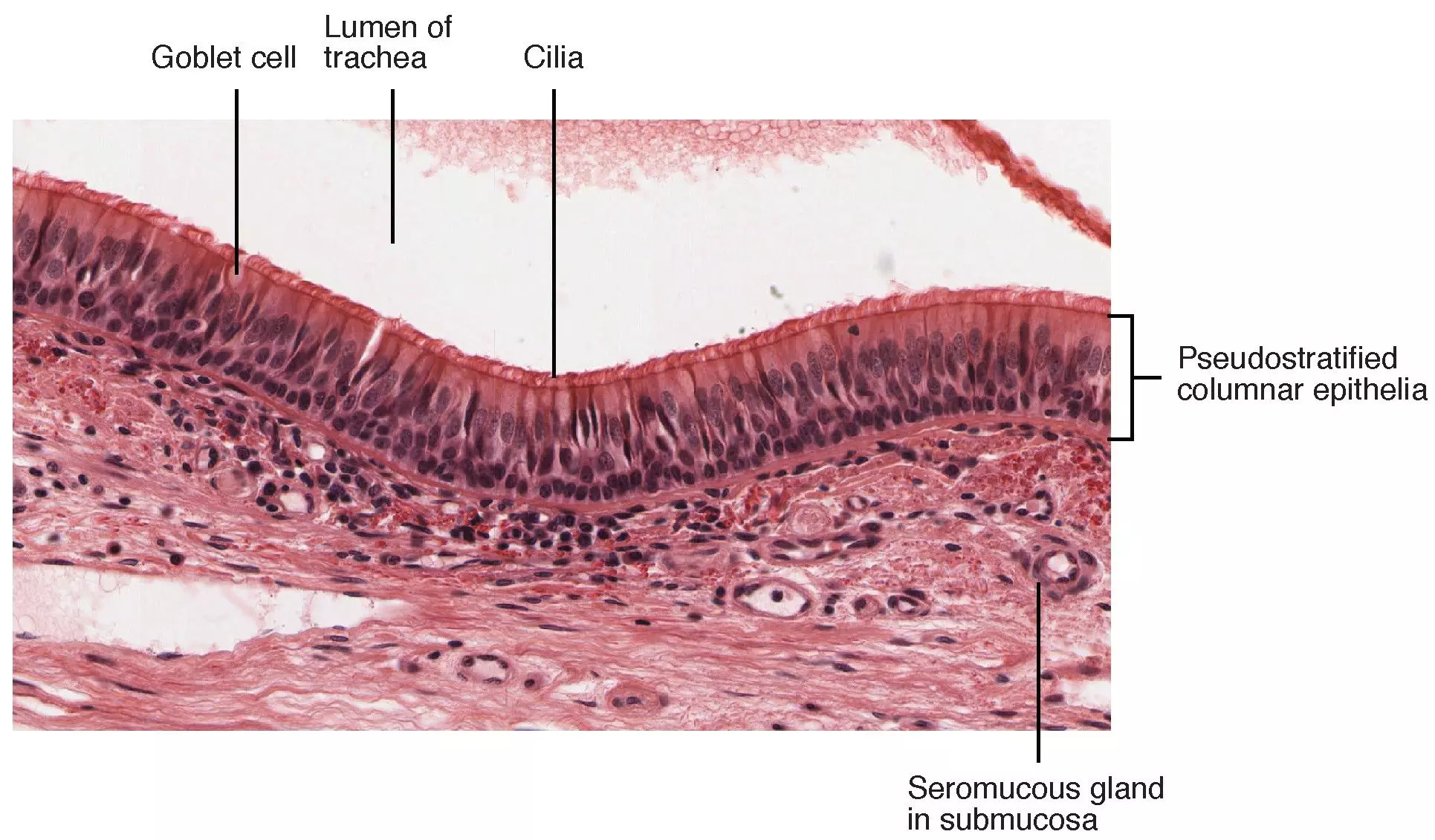
Diagram - Histological section of the trachea
Creative commons source by OpenStax College [CC BY-SA 4.0 (https://creativecommons.org/licenses/by-sa/4.0)]
Chronic Obstructive Pulmonary Disease
When a patient is suffering from Chronic Obstructive Pulmonary Disease (COPD), they will have hyperplasia of the goblet cells and hypertrophy of the submucus glands leading to an increased ratio of mucus cells to ciliated cells. This causes inflammation of the airways, and increased mucus production, meaning the patients with this disease have an increased risk of developing infections as microorganisms cannot be transported from the airways to the pharynx as efficiently anymore. For more information see our article on COPD.
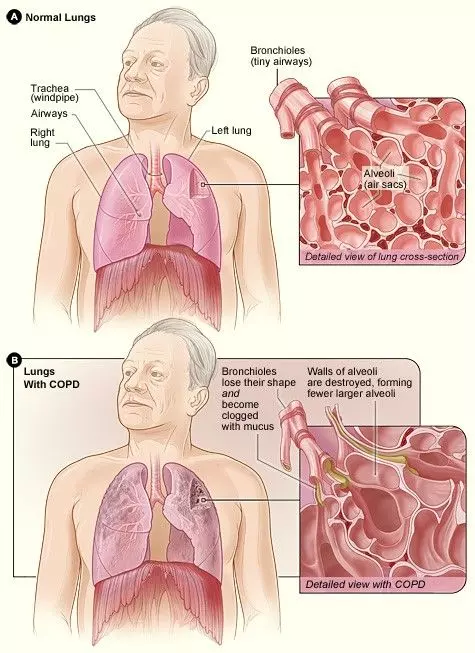
Diagram - The lungs of someone with COPD versus the lungs of someone without COPD
Public Domain Source by National Heart Lung and Blood Institute [Public domain]
A patient who is suffering from cystic fibrosis (CF) will have more viscous mucus due to a defect in the cystic fibrosis transmembrane regulator (CFTR), which is a transporter present on the luminal side of the cells lining the airways. This defect leads to fewer chloride ions being transported from inside the cell into the mucus, meaning less water moves out of the cells causing the mucus to be more viscous. As a result of this defect, patients suffering from cystic fibrosis are more likely to suffer from repeated pulmonary infections as the mucus in the airways is struggles to move up to the pharynx.
The bony thorax is composed of the sternum, twelve pairs of ribs and the twelve thoracic vertebrae of the spine. The lungs are ventilated by the bony thorax, the intercostal muscles and the diaphragm functioning together.
The first seven ribs are attached to the sternum through the costal cartilage, whilst the eighth, ninth and tenth ribs are attached to the costal cartilage of the seventh rib. The eleventh and twelfth rib terminate in the abdominal musculature.
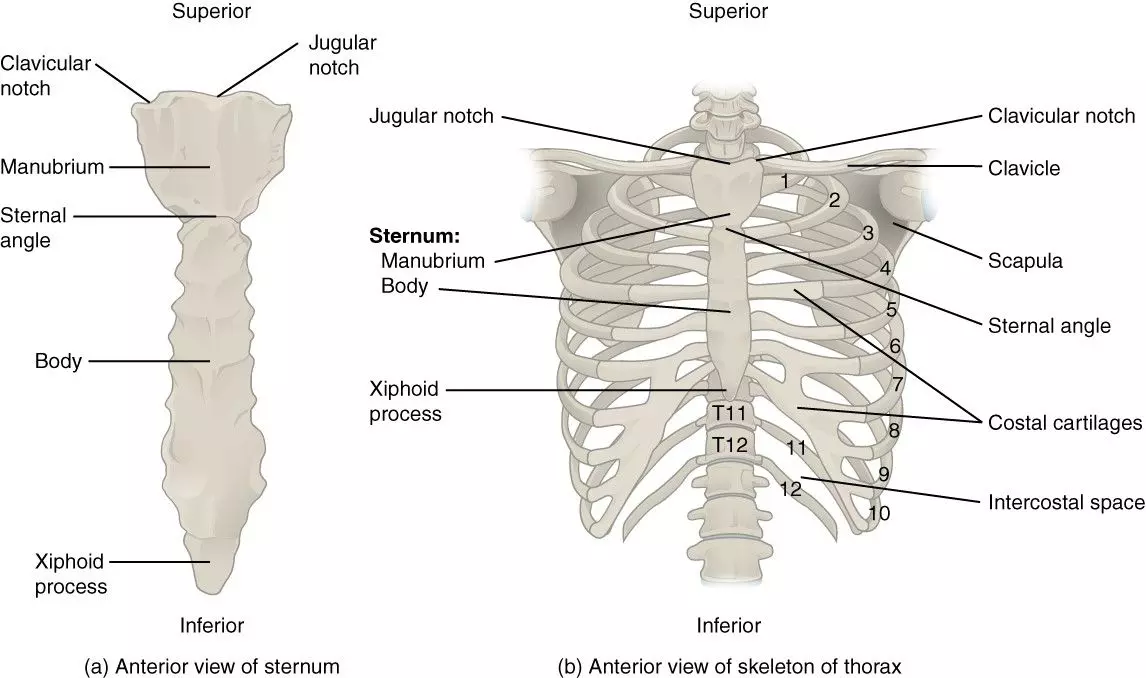
Diagram - The thoracic cavity, showing the sternum, ribs and costal cartilages
Creative commons source by OpenStax College [CC BY-SA 4.0 (https://creativecommons.org/licenses/by-sa/4.0)]
There are three muscles found in each intercostal space and they are all innervated by the intercostal nerves. These muscles are (from superficial to deep):
External Intercostal Muscles – the most superficial intercostal muscles. The fibres of these muscles project inferiorly and anteriorly. The external intercostal muscles are responsible for around 30% of chest expansion during quiet respiration.

Image - The external intercostal muscles
Creative commons source by Anatomography [CC BY-SA 4.0 (https://creativecommons.org/licenses/by-sa/4.0)]
Internal Intercostal Muscles – the fibres of these muscles project inferiorly and posteriorly. They pull the ribs inferiorly during chest expansion and used for forced expiration.
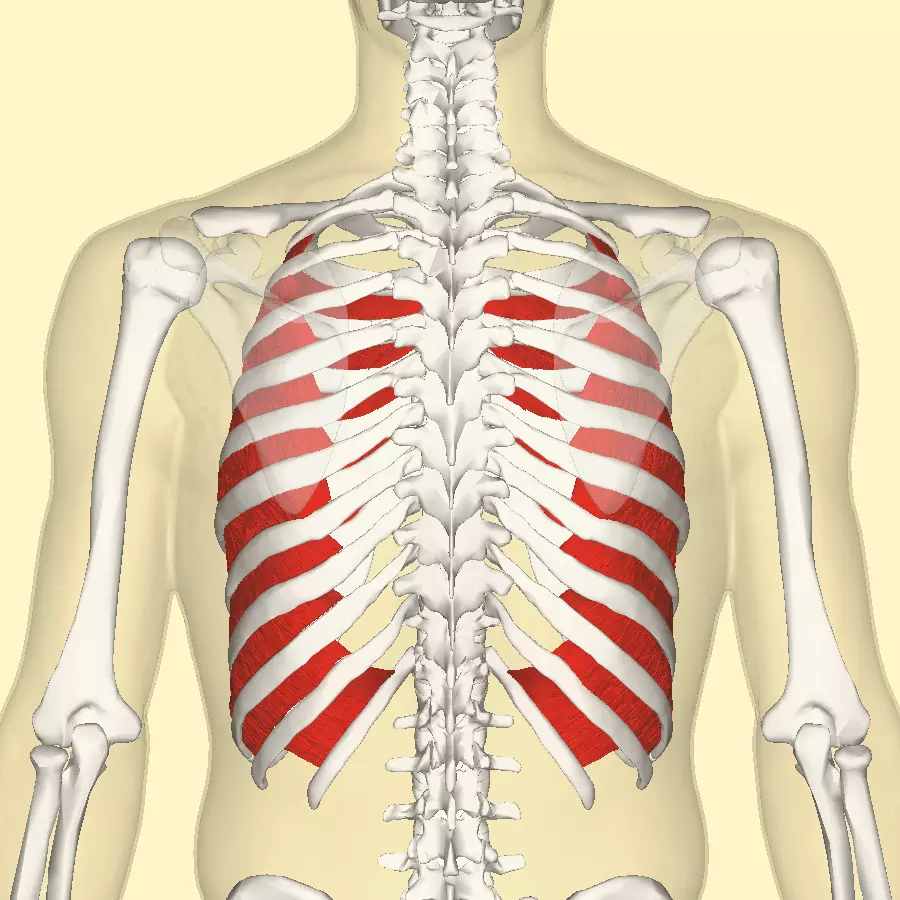
Image - The internal intercostal muscles
Creative commons source by Anatomography [CC BY-SA 4.0 (https://creativecommons.org/licenses/by-sa/4.0)]
Innermost Intercostal Muscles – the deepest intercostal muscles. These muscles are used alongside internal intercostal muscles during forced expiration.
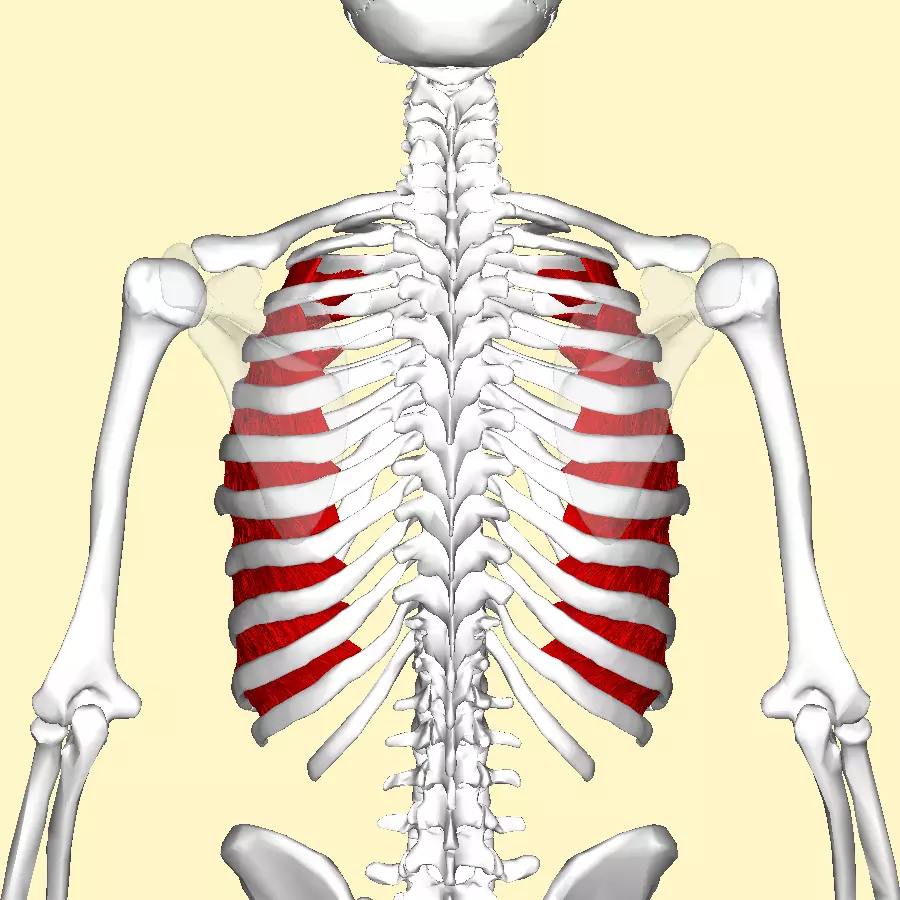
Image - The innermost intercostal muscles
Creative commons source by Anatomography [CC BY-SA 4.0 (https://creativecommons.org/licenses/by-sa/4.0)]
The Intercostal Arteries, Veins and Nerves
The neurovascular bundle that supplies the intercostal muscles runs on the inferior border of each rib, and therefore superiorly in the intercostal space.
The first nine intercostal spaces are supplied by three vessels each: two anterior intercostal arteries and one posterior intercostal artery. The final two intercostal spaces (tenth and eleventh) are supplied solely by the posterior intercostal arteries.
The first two posterior intercostal arteries are branches of the superior intercostal artery whereas the final nine posterior intercostal arteries derive from the thoracic artery.
The first six anterior intercostal arteries arise from the internal thoracic artery and the final three anterior intercostal arteries arise from the musculophrenic arteries.
Regarding the venous drainage of the intercostal spaces, there are eleven pairs of posterior intercostal veins and nine pairs of anterior intercostal veins (supplying spaces 1-9). With the anterior intercostal veins, the first six pairs drain directly into the internal thoracic vein and the final two veins drain firstly into the musculophrenic vein before draining into the internal thoracic vein. The majority of the posterior intercostal veins drain into the azygous or hemiazygous veins.
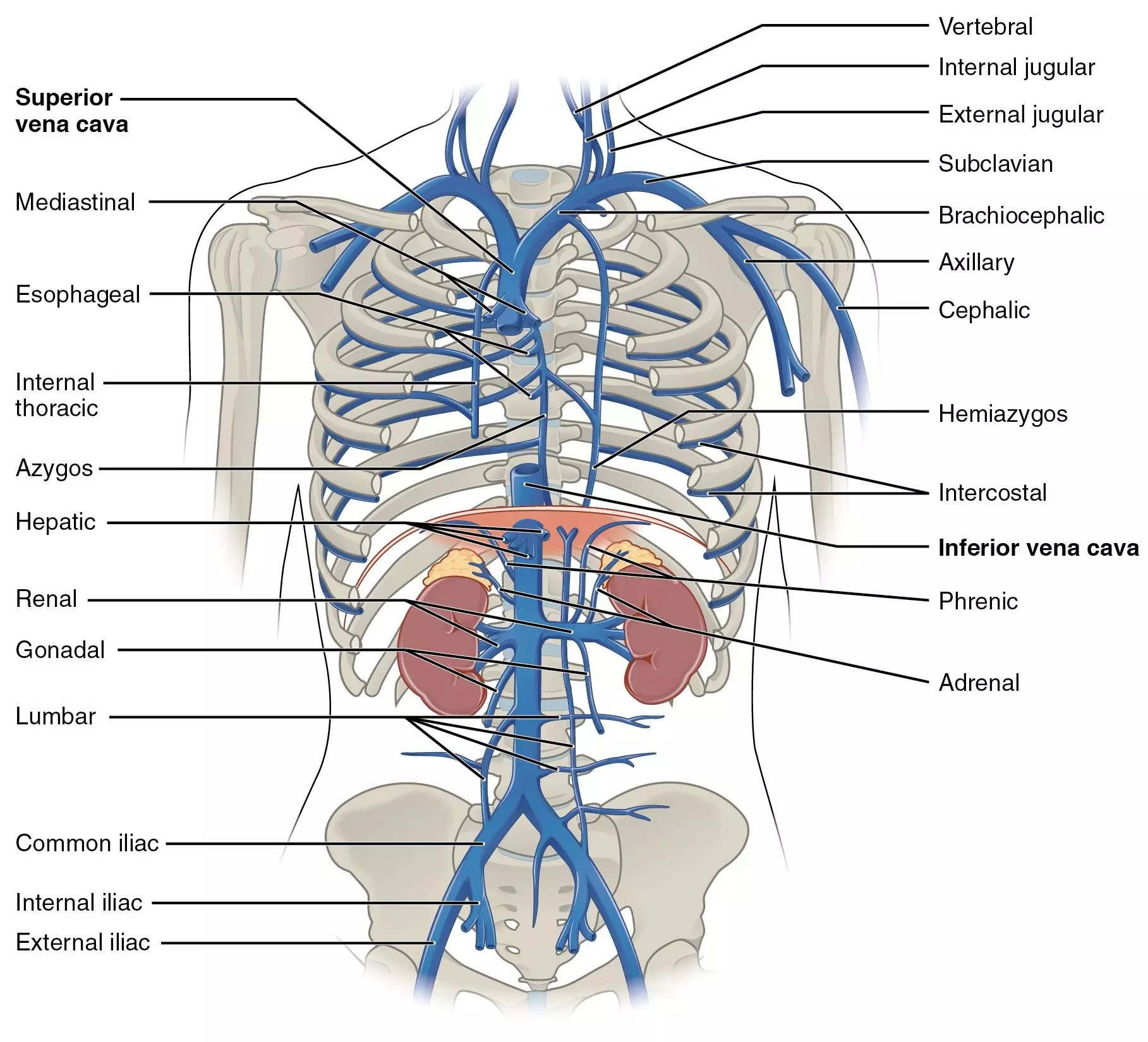
Diagram - The azygos and hemiazygos veins alongside the other veins in the thoracic region
Creative commons source by OpenStax College [CC BY-SA 4.0 (https://creativecommons.org/licenses/by-sa/4.0)]
The intercostal nerves arise from the anterior rami of the first eleven thoracic spinal nerves and the anterior rami of the twelfth thoracic spinal nerve lies in the abdomen as the subcostal nerve.
When performing a chest drain, the tube should be inserted into the intercostal space at the superior border of the lower rib (inferior in the space) to avoid damaging the neurovascualr structures found in the intercostal space.
The diaphragm is the main muscle responsible for chest expansion during inspiration. The muscle is dome-shaped at rest but during contraction it flattens with the muscle moving downwards, increasing the vertical diameter of the chest cavity.
The diaphragm is split into a right and a left dome or hemidiaphragm. The right dome of the diaphragm is found at the level of the fifth rib and the left dome is found at the level of the fifth intercostal space. The right dome is higher in comparison to the left dome due to the liver pushing the right dome superiorly.
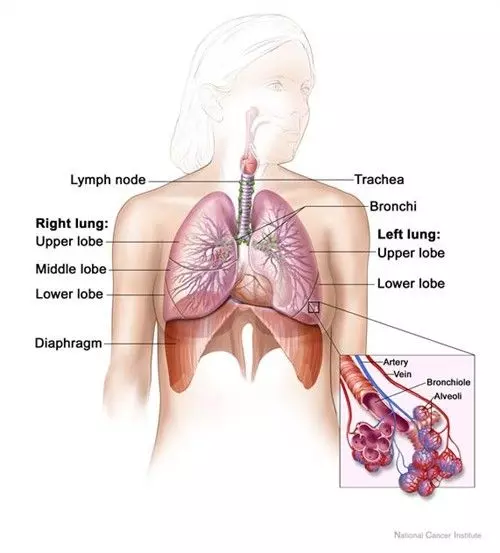
Diagram - The lungs and the diaphragm
Public Domain Source by National Cancer Institute [Public domain]
The diaphragm is innervated by the left and right phrenic nerves (made up of cervical nerves 3, 4 and 5) which supply the left and right hemidiaphragms respectively. This means if either nerve is damaged, there is paralysis of the affected side of the diaphragm. This can be seen on a chest x-ray, as the affected side will appear as a dome despite the x ray being taken when the patient is breathing in.
The diaphragm has three openings for three important structures. These are the inferior vena cava at the level of thoracic vertebrae 8 (T8), the oesophagus at the level of T10 and the aortic hiatus, which allows the passage of the aorta through the diaphragm, at the level of T12. This can be remembered by the vena cava having 8 letters (T8), the oesophagus having 10 letters (T10), and the aortic hiatus having 12 letters (T12)
The Movements of the Thoracic Wall and Diaphragm During Respiration
During the process of inspiration, the ribs swing superiorly and laterally, which increases the lateral diameter of the thoracic space. This movement is known as the 'bucket handle' movement, because this movement is similar to the handle of the bucket.
The sternum moves anteriorly during inspiration to increase the anterior-posterior diameter as the diaphragm descends to increase the thoracic capacity. This is called the 'pump handle' movement, because this is a similar movement to the handle of an old-fashioned water pump.
The Pleura and the Pleural Cavity
The pleura is the serous membrane that lines the lungs and the thoracic cavity. The pleura is composed of two membranes – the parietal and the visceral membranes. The parietal pleura lines the inside of each hemi-thorax, meaning it is stuck to the inside of the chest wall. The visceral pleura lines the outside of the lungs and extends into the interlobar fissures, meaning that it is stuck to the outside of the lungs. The function of the pleura is to ensure the lungs expand and inflate as the thorax expands during inspiration.
Between the parietal and visceral pleura is a small cavity, known as the pleural cavity, that contains a small volume of fluid, the pleural fluid. This fluid allows the pleura to slide effortlessly over each other during the movements of respiration. The pleural fluid also acts to keep the lung inflated against the chest wall, because of negative pressure within this cavity.
As the lungs do not completely fill the thoracic space, there are potential spaces formed between the pleura covering the diaphragm and the costal surface, these are known as the costo-diaphragmatic recesses. This is clinically important as pleural effusions can develop here through gravity, and can can be seen on a chest X-ray.
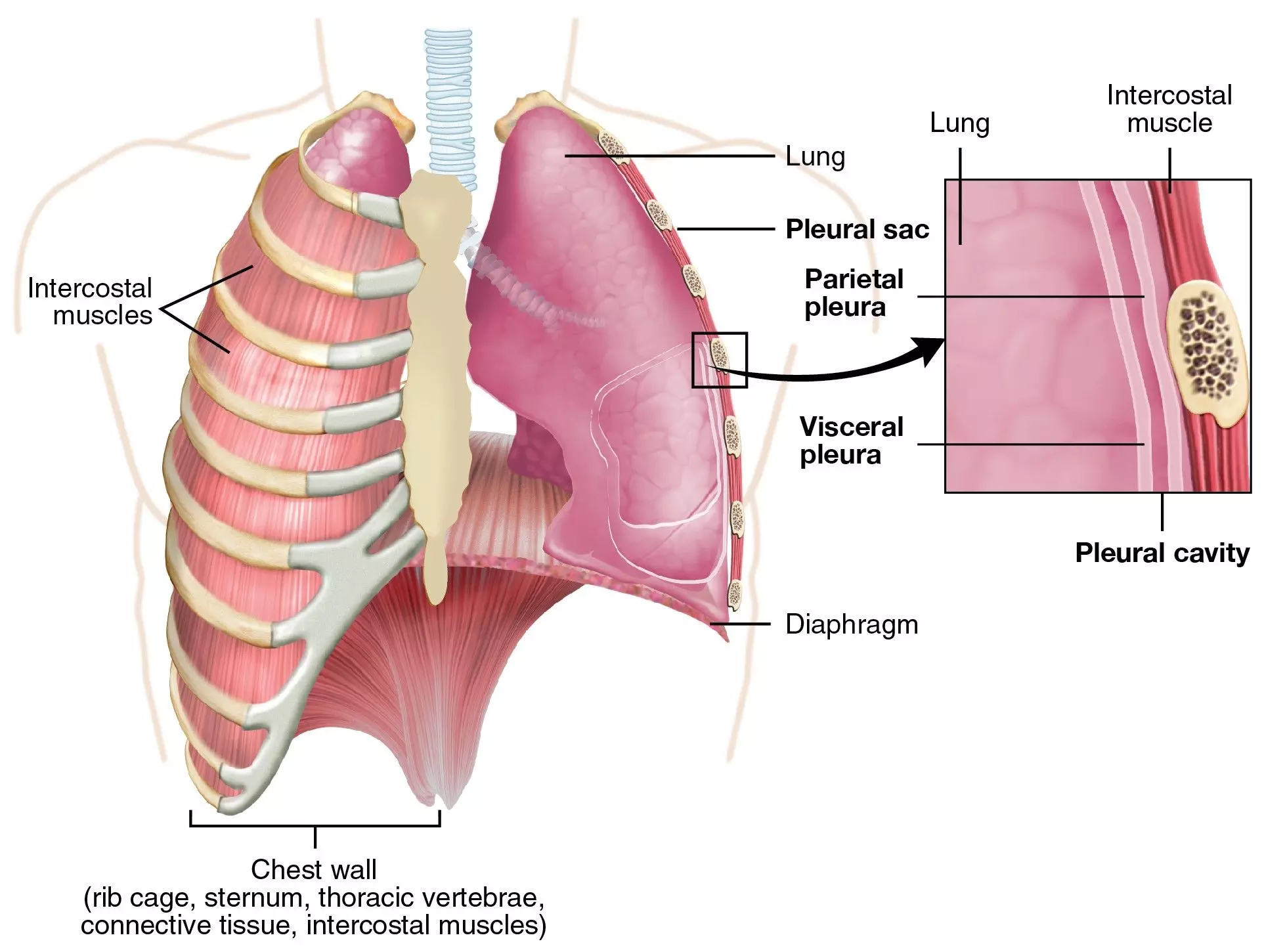
Diagram - The pleura and the pleural cavity
Creative commons source by OpenStax College [CC BY-SA 4.0 (https://creativecommons.org/licenses/by-sa/4.0)]
The Trachea and the Bronchial Tree
The trachea commences at the lower border of the cricoid cartilage and then terminates by dividing into the right and left main bronchi around the level of T6 opposite the sternal angle. The angle between the right and left bronchi is called the carina.
The right main bronchus is shorter, wider and more vertical in comparison to the left main bronchus, meaning inhaled objects are more likely to lodge in the right main bronchus.
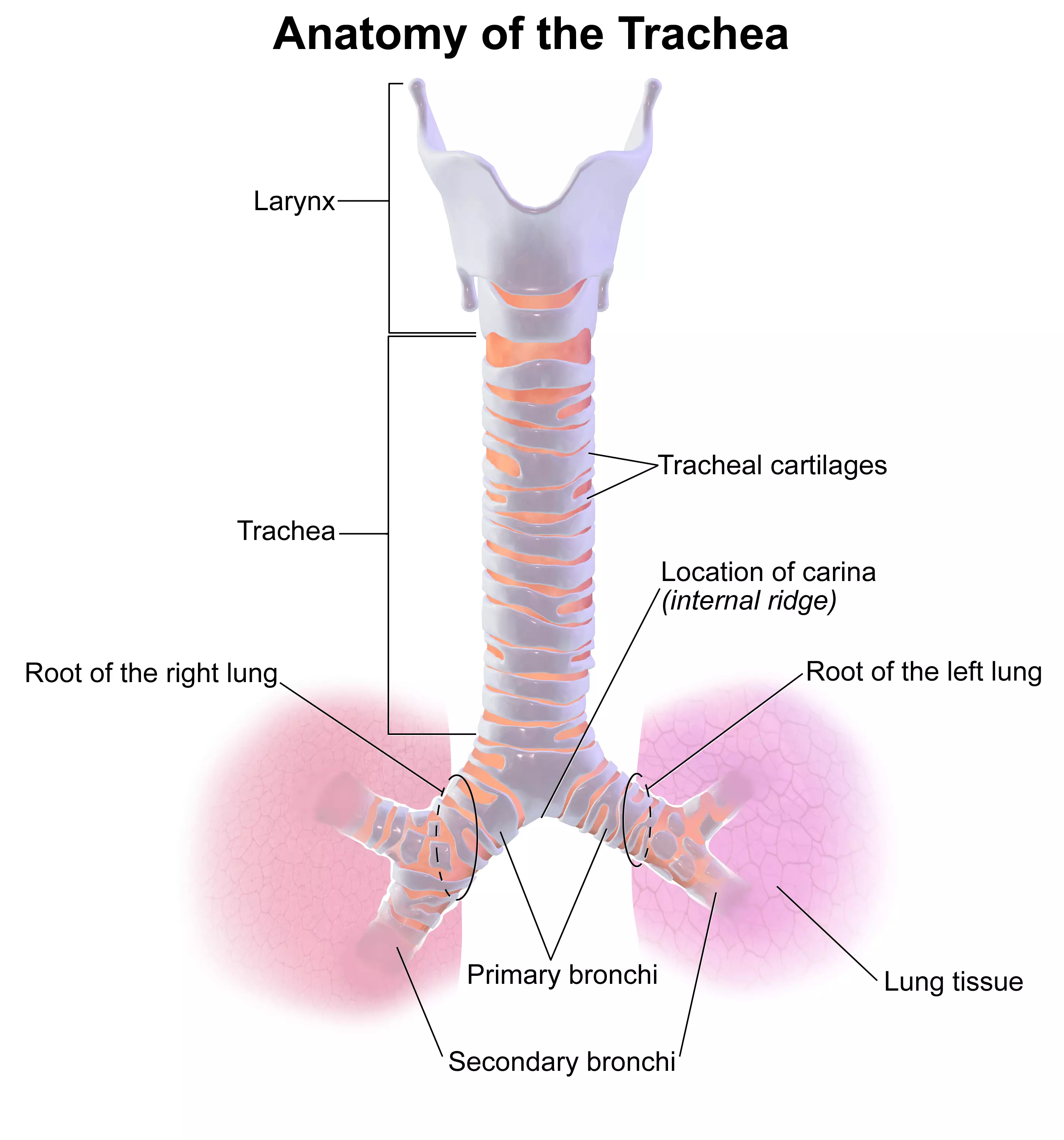
Diagram - The anatomy of the trachea
Creative commons source by Blausen.com staff (2014). "Medical gallery of Blausen Medical 2014". WikiJournal of Medicine 1 (2). DOI:10.15347/wjm/2014.010. ISSN 2002-4436
[CC BY-SA 4.0 (https://creativecommons.org/licenses/by-sa/4.0)]
The right and left bronchi can be known as the primary bronchi and these divide into the lobar or secondary bronchi. There are three right lobar bronchi and two left lobar bronchi, relating to the number of lobes in each lung. Each lobar bronchi divides into a segmental or tertiary bronchi, which each supply a bronchopulmonary segment.
A bronchopulmonary segment is an area of lung that is supplied by the segmental branch of the pulmonary artery, drained by a branch of the pulmonary vein and has a segmental bronchi. It is possible if needed to remove one bronchopulmonary segment with very little bleeding & gas leakage, because each segment is relatively separated from the next.
The left lung has two lobes (upper and lower) whereas the right lung has three lobes (upper, middle and lower).
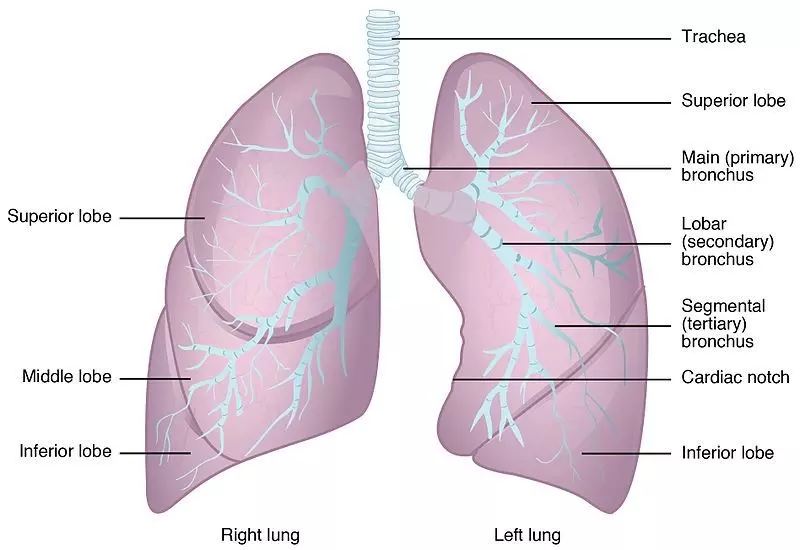
Diagram - The lobes and bronchi of the lungs
Creative commons source by OpenStax College [CC BY-SA 4.0 (https://creativecommons.org/licenses/by-sa/4.0)]
The apex of each lung ascends to the root of the neck, above the first rib. This area is close to many vascular and neurological structures (like the brachial plexus and subclavian arteries), meaning that a patient with a tumour in this area can present with vascular or neurological symptoms.
For example, a patient with a Pancoast tumour of the apex of the lung can present with symptoms of Horner’s syndrome (ptosis, mitosis and anhydrosis of the ipsilateral side of the face including the ipsilateral eye) because the tumour impinges on the sympathetic nerves present in this area.
The base of each lung rest on a hemi-diaphragm.
The hilum of each lung is found on the mediastinal surface (closest to the heart) of each lung and contains the following structures: main bronchi, pulmonary artery and vein, lymphatics, bronchial arteries and veins.
The structures next to the mediastinal surface of the left lung include the heart, aortic arch, descending aorta, oesophagus and nerves including the phrenic, vagus and recurrent laryngeal nerves.
Structures next to the mediastinal surface of the right lung include the superior vena cava, azygous vein, right atrium, oesophagus and nerves such as the phrenic nerve, vagus nerve and the sympathetic trunk.
The Neurovascular Supply of the Lungs
The lungs have a dual blood supply via the bronchial and pulmonary arteries.
The bronchial arteries supply the bronchial tree (airways), not the alveoli, and the visceral pleura with oxygenated blood. The majority of the blood returns to the heart via the pulmonary veins with the minor portion returning to the heart via the superior vena cava. This is the blood that comes to the lungs oxygenated, and leaves deoxygenated.
The pulmonary arteries carry the entire cardiac output of the right ventricle to the lungs for the process of gaseous exchange and supply the alveoli at the same time. This is the blood that comes to the lungs deoxygenated, and leaves oxygenated.
The pulmonary veins return the oxygenated blood to the left side of the heart, which is then pumped around the body to supply oxygen to the tissues.
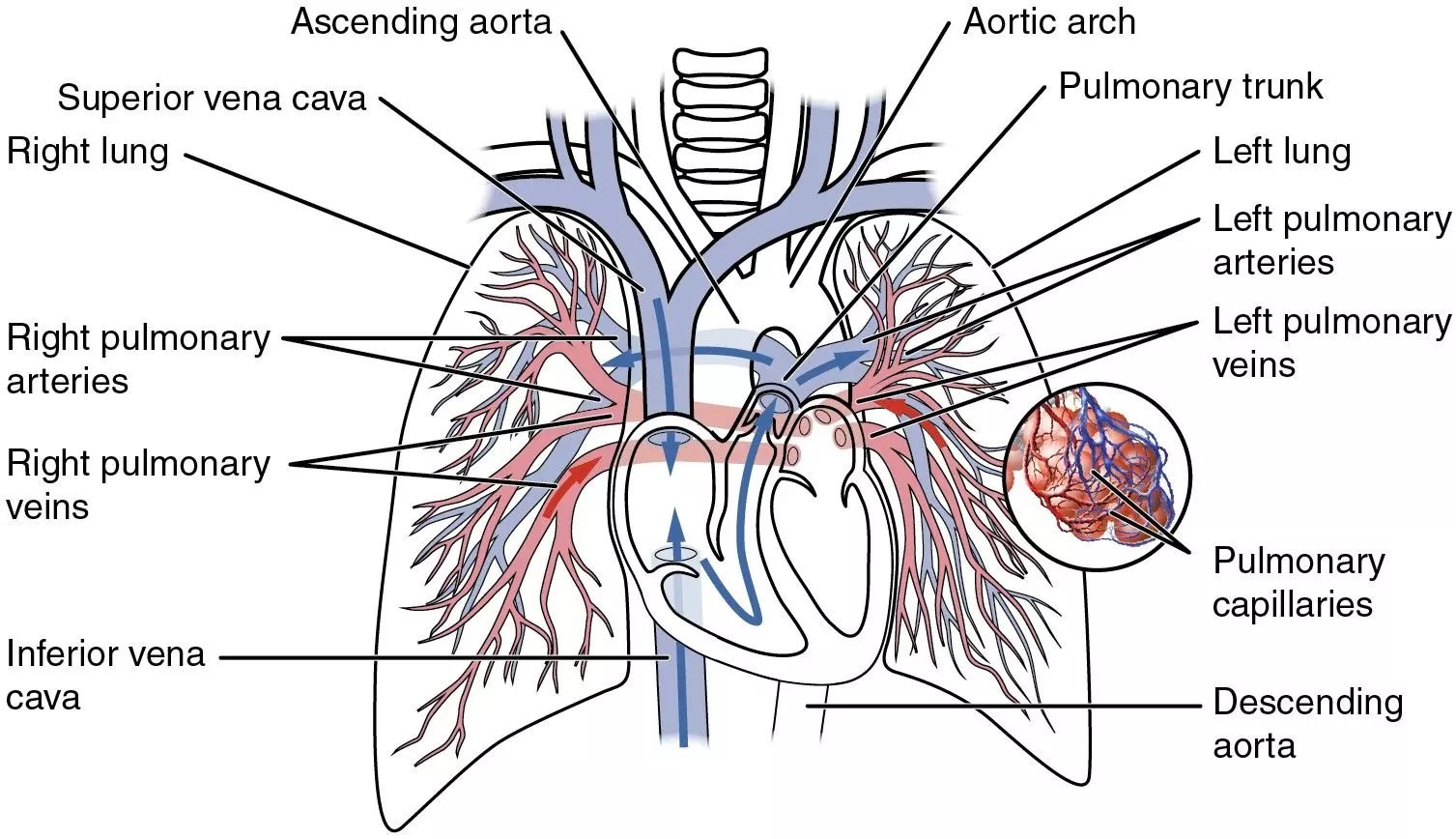
Diagram - The pulmonary circulation, showing the pulmonary arteries and veins
Creative commons source by OpenStax College [CC BY-SA 4.0 (https://creativecommons.org/licenses/by-sa/4.0)]
The lymphatics of the visceral pleura and the lungs drain into the hilar nodes (bronchopulmonary nodes) and from here, they drain into the tracheobronchial nodes.
The nerve supply to the lungs includes the right and left vagus nerves, and the sympathetic trunk.
- The vagus nerve contains some parasympathetic efferent fibres which supply motor innervation to bronchial smooth muscle. Activation of these fibres leads to bronchoconstriction and secretomotor to the mucous glands.
- The afferent fibres of the vagus nerve are sensory and are responsible for the coughing reflex.
- The sympathetic efferent fibres cause bronchodilation and vascoconstriction when they are activated.
Visualising the Lobes of the Lungs and The Pleural Cavity
The upper and lower lobes of the left lung are separated by the oblique fissure. The right upper and middle lobes are separated by the horizontal fissure, whilst the oblique fissure separates the middle and lower lobes of the right lung.
The oblique fissure on both sides extends from the spinous process of T2 posteriorly to the sixth costal cartilage anteriorly.
The horizontal fissure on the right side extends from the mid-axillary line anteriorly along the fourth rib to the anterior edge of the lung and this fissure is only present on the right lung.
Edited by: Dr. Maddie Swannack and Dr. Thomas Burnell
- 14678

